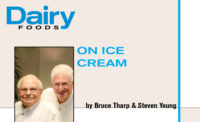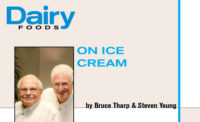New factors will affect the composition of ice cream once changes to nutrition labeling regulations become effective mid-year 2018. These include a declaration of “added sugars” (in grams and in the percent recommended daily value, or RDV, per serving). Considering a value of 4 calories per gram for conventional sugars, the RDV for “added sugars” has been established as 50 grams, the amount representing 10% of a recommended daily intake of 2,000 calories. The quantitative nature of this declaration is further affected by an increase in the standard serving size of ice cream from one-half cup to two-thirds cup.
The current definition of added sugars is the sum of all the mono- and disaccharides present (except lactose from dairy ingredients), appropriate portions of corn syrup solids and naturally occurring sugars in honey and concentrated juices.
This is likely to intensify interest in minimizing the amount of added sugars declared on the package, either by reducing the amount of sugars added and/or increasing overrun to reduce the weight of the larger serving size volume. Such changes affect both the amount and quality of sweetness and body/ texture. Thus, it is important to give careful consideration to ingredient selection, formulation, freezing point management, water mobility control and whipping/freezing conditions. Other considerations are how to create and stabilize small ice crystals and air bubbles.
Compositional approaches
Classically, added sugars can be reduced by using high-intensity sweeteners. “Sugars” can be replaced with bulking agents (e.g., low DE maltodextrin) and/or a higher level of corn syrup solids, (which contain up to ~25% added sugars.) This requires managing the effect on freezing point and water mobility control, including careful consideration of the amount and type of hydrocolloid stabilizers used.
Allulose, a so-called “rare sugar,” has potential for reducing added sugars. This GRAS (generally recognized as safe) monosaccharide has a sweetness equivalence similar to sucrose. Thus, allulose remains a sugar which would not be useful in reducing added sugars. However, since it contributes virtually no calories, it makes no significant contribution to the RDV of added sugar. Accordingly, a petition has been submitted to exempt allulose from declaration as an added sugar. Should that occur, allulose would become a valuable tool.
Sugar alcohols can be used as partial replacements of sucrose. Maltitol syrup is particularly useful. When properly used, it can be the sole source of sweetness and adds no sugars, as they are defined. Maltitol syrup also contains polyglycitol (hydrogenated starch hydrolysates), which provides significant water mobility control.
Processing considerations
Following are techniques to consider in the manufacturing of ice cream:
- Freeze more water in the barrel of the freezer, where conditions maximize the formation of small ice crystals. The lower the draw temperature, the smaller will be the size of ice crystals at packaging.
- Produce smaller, more stable air bubbles through the application of pre-aeration, which will also minimize ice crystal growth. In addition, improve the stability of small air bubbles by selecting the proper emulsifiers.
- Hydrolysis of lactose adds more sweetness but also more added sugars, which may allow partial replacement of sucrose on an equivalent sweetness basis. Similarly, physical removal of lactose with subsequent partial replacement with sucrose is possible. Success will depend on other, as yet unknown, compositional considerations.
- Increase hardening rate, particularly through higher temperature ranges, where rapid growth of ice crystals and air bubbles occurs. Partial cryogenic hardening has been found to be particularly effective. It is also important to minimize exposure to those temperatures during distribution.
Monitor with a formulation index
Formulation indices are useful tools for evaluating the effect of compositional changes on key phenomena that directly influence sensory appeal. Comparative indices within acceptable ranges represent practical equivalencies. Indices outside acceptable ranges indicate a need to reformulate. Within those ranges, only actual testing will ascertain true differences between formulations. Thus, indices offer guidance as to when to reformulate or when to test. Consider using the following:
- Theoretical sweetness. Changes of ± 0.5 % are functionally equivalent.
- Freezing profile indices reflect average initial ice crystal size (Freezer Index) and growth during heat shock (Texture Stability Index.) A ± 0.5 F freezing point difference represents practical equivalency.
- Water control index reflects the ability of mix components to influence the growth of ice crystals and air bubbles via control of water mobility. WCIs +/- 5% are considered functionally equivalent.
Thus, a number of ingredient, formulation and process considerations are necessary to make technology-based decisions to reduce added sugars in frozen desserts.
This column is adapted from a presentation made at the 2017 Ice Cream Technology Conference put on by the International Dairy Foods Association.




